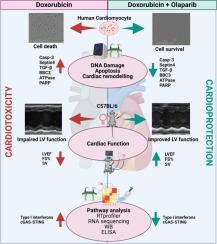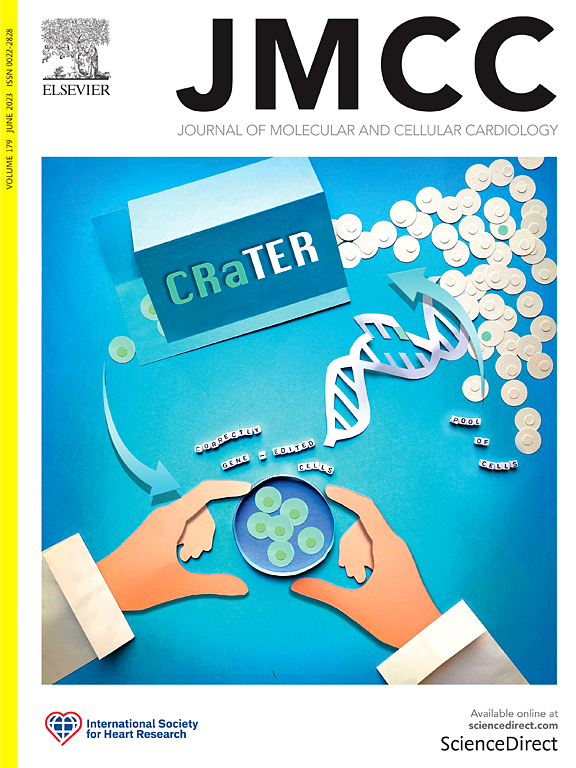Anti-cancer agent Olaparib ameliorates doxorubicin-induced cardiotoxicity in vitro and in vivo
IF 4.7
2区 医学
Q1 CARDIAC & CARDIOVASCULAR SYSTEMS
引用次数: 0
Abstract
Inhibition of poly (ADP-ribose) polymerase (PARP) has shown cardioprotective effects in myocardial injury, and PARP activation has been implicated in Doxorubicin-induced cardiotoxicity (DIC). Thus, PARP inhibition may be a potential preventive therapy for DIC. The present study aims to determine the cardioprotective effects of Olaparib in preventing DIC in in vitro and in vivo models. In vitro: Human cardiomyocytes (HCM) were treated with Doxorubicin at 1 μM (EC50) +/− 80 μM of Olaparib for 48 and 72 h, assessing cell viability (CellTiter-Glo®) and conducted gene expression analysis; Concomitant Olaparib treatment prevented Doxorubicin-induced impairment of HCM viability. Doxorubicin induced upregulation of mRNA expressions of genes involved in apoptosis: CASP3; DNA damage: BBC3; and cardiac remodeling: TGF-β; −all were reversed by Olaparib. In vivo: Female C57BL/6 mice were administered intraperitoneally either: A) vehicle of 0.9 % saline and 8 % DMSO in PBS; B) Doxorubicin at 5 mg/kg/wk. for 5 weeks; C) Olaparib at a dose of 50 mg/kg in 8 % DMSO, administered 3 times/week; D) Olaparib at 50 mg/kg, administered 3 times/week, started one week prior to commencement of Doxorubicin treatments at 5 mg/kg/week. Serial echocardiography was performed. mRNA, protein expressions and RNA sequencing were performed in the cardiac tissues; Doxorubicin induced significant LV dysfunction after 6 weeks of treatment; whereas the mice treated with Olaparib in combination with Doxorubicin showed preservation of cardiac function. Analysis of RNA-seq and Western blot data suggested that Olaparib's cardioprotective effects in DIC may involve regulating innate immune responses by lowering cGAS-STING levels, elevated by Doxorubicin. Olaparib protects HCM against DIC both in vitro and in vivo. This is mediated in part via cGAS-STING pathway.

抗癌药物奥拉帕尼改善阿霉素诱导的体外和体内心脏毒性
抑制聚adp核糖聚合酶(PARP)在心肌损伤中显示出心脏保护作用,PARP的激活与阿霉素诱导的心脏毒性(DIC)有关。因此,抑制PARP可能是DIC的潜在预防治疗方法。本研究旨在确定奥拉帕尼在体外和体内模型中预防DIC的心脏保护作用。体外:人心肌细胞(HCM)在1 μM (EC50) +/−80 μM的奥拉帕尼剂量下用阿霉素处理48和72 h,评估细胞活力(CellTiter-Glo®)并进行基因表达分析;同时使用奥拉帕尼治疗可防止阿霉素引起的HCM活力损害。阿霉素诱导凋亡相关基因CASP3 mRNA表达上调;DNA损伤:BBC3;和心脏重塑:TGF-β;-所有这些都被奥拉帕尼逆转。在体内:雌性C57BL/6小鼠腹腔注射:A) 0.9%生理盐水和8% DMSO的PBS;B)阿霉素5mg /kg/周。5周;C)奥拉帕尼50mg /kg, 8% DMSO,给药3次/周;D)奥拉帕尼50mg /kg,给药3次/周,在阿霉素5mg /kg/周治疗开始前一周开始。进行连续超声心动图检查。进行心脏组织mRNA、蛋白表达及RNA测序;阿霉素治疗6周后引起明显的左室功能障碍;而奥拉帕尼联合阿霉素治疗的小鼠显示出心脏功能的保存。RNA-seq和Western blot数据分析表明,奥拉帕尼在DIC中的心脏保护作用可能通过降低cGAS-STING水平来调节先天免疫反应,而阿霉素升高了cGAS-STING水平。奥拉帕尼在体外和体内均可保护HCM抗DIC。这部分是通过cGAS-STING途径介导的。
本文章由计算机程序翻译,如有差异,请以英文原文为准。
求助全文
约1分钟内获得全文
求助全文
来源期刊
CiteScore
10.70
自引率
0.00%
发文量
171
审稿时长
42 days
期刊介绍:
The Journal of Molecular and Cellular Cardiology publishes work advancing knowledge of the mechanisms responsible for both normal and diseased cardiovascular function. To this end papers are published in all relevant areas. These include (but are not limited to): structural biology; genetics; proteomics; morphology; stem cells; molecular biology; metabolism; biophysics; bioengineering; computational modeling and systems analysis; electrophysiology; pharmacology and physiology. Papers are encouraged with both basic and translational approaches. The journal is directed not only to basic scientists but also to clinical cardiologists who wish to follow the rapidly advancing frontiers of basic knowledge of the heart and circulation.

 求助内容:
求助内容: 应助结果提醒方式:
应助结果提醒方式:


